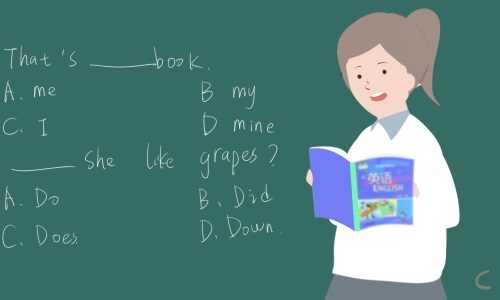随着全球化的不断加深,英语显得十分重要,特别是对于那些要与外国人交流的人来说。一方面,英语是了解外界的必备因素。下面是小编为大家整理的有关英语七年级下册知识点经典版合集,希望对你们有帮助!

英语七年级下册知识点经典版合集
2.ving形式的构成
1)直接在动词原形末尾加-ing,如play-playing
2)以不发音字母e结尾的动词,去e再加-ing,如have-having
3)以重读闭音节结尾的单词,结尾只有一个辅音字母,应双写这个字母,再加-ing。如,begin-beginning
注意:
1) 有些动词一般不用于现在进行时,如see,like,love, want,know等,而用一般现在时。如,Do you know him?你认识他吗?
2) 有些动词如come, go, arrive, leave, start, fly, drive,stay等表示位置转移的词,用现在进行时表示按计划即将发生的动作,如 We are going to Beijing on Friday.我们星期五要去北京。
3. 构词知识:
1) 名词后缀:-er,如,singer
-or,如 actor
-ing, 如 meeting
-tion 如 direction
2) 形容词后缀: -ful 如,beautiful
-ing 如,boring
-ous 如,dangerous
-ly 如, friendly
3)副词后缀:-ly 如,really
4)数词后缀:-teen 如,thirteen
-ty 如,thirty
-th 如,fourth
5)在国家名词后加-ian,-an, -n表示其国家的人。如,
Egypt埃及 Egyptian埃及人
Europe欧洲 European欧洲人
Canada加拿大 Canadian加拿大人
Italy意大利 Italian意大利人
Australia澳大利亚 Australian澳大利亚人
America美国 American美国人
6)在表示天气的名词后加-y如,wind-windy, fog-foggy,sun-sunny
4. Until的用法:
Until 和 till的意义相同,都有“直到”,“直到...才","在...以前不"的意思.它们的使用方法为:
1) 作介词: 作介词,后面通常接表时间的名词或短语.如We are back until/till3o’clock.三点种我们才回来.
2) 作连词: 作连词时,until和till引导时间状语从句.如 Go along this road until you see the park沿着这条路走,直到你看到公园为止。
【注意】1)以上的状语从句的例句都是从句在主句之后,如果把从句放在主句之前,那么,引导词用till.如Till you come back, I won’t leavehere.直到你回来我才回离开这。
3) 主句的动作是终止性的,要用not…until/till句型。
5.“违反规矩“的现在进行时态
1) 现在进行时比哦按时目前这一段时间内的活动或现阶段正在进行的动作。而说话时并不一定正在进行。如Is Tom working hard this term?汤姆这学期学习用功吗?
They are working on the farm these days.这些日子他们在农场劳动。
2) 表示往返或位置转移的动词,如come,go,leave, stay, start, arrive等构成的现在进行时,可表示按计划或安排即将发生的动作。这些动词还可以和表示将来的时间状语,如tomorrow, next week, next year等连用。
They are leaving for Beijing tomorrow.明天他们要动身去北京。
4) 现在进行时与always, often等词相结合,也可表示习惯的,经常重复的动作。意思是“老是”,“总是”。此时常带有一定的感情色彩,如:埋怨,赞赏等。如
Mary is always talking about her son.玛利总是谈论她的儿子。
【注意】一些表示状态和意愿的动词,如be,like,want,know ,think,have等,不能用于现在进行时态中。如,I want to go home now.
6. 关于how 的用法
1) How作“(指程度)多少”“(方法)怎样”“多么”讲,为副词。
2) how 的感叹句的构成:How + 形容词+主语+be动词!
How+副词+主语+谓语动词!
3)how many 多少(对可数名词的数量提问,其后接名词复数)
How many days are there in a year?
4) how much 多少(钱)(对不可数名词的数量提问,其后接不可数名词)
How much water is there in the cup?
How much are these pants?
5) how often多久(对表示频度副词的时间状语提问)
How often do you go there? Once a month.
6)how old多大岁数(对年龄提问)
How old is your grandfather? He is sixty-five.
7)how soon多久(用于将来时)
How soon are you back? In a week.
◆unit10 Where did you go on vacation?
目标语言:Talk about past events
重点句型:Where did Tina go on vacation? She went to the mountains.
Where did he go on vacation? He stayed at home.
Did you go to Central Park? Yes, I did. No, I didn’t.
Did he go to Central Park? Yes, he did. No, he didn’t.
How was your vacation? It was pretty good.
How was the weather? It was hot and humid.
How were the people? They were unfriendly.
We had great fun playing in the water.
The shops were too crowded, so I didn’t really enjoyed it.
I found a little boy crying in the corner.
重点词组: stay at home, go to New York City, summer camp, go to the mountains, on vacation, Central Park, go to the movies,pretty good, bus trip, have fun doing, go shopping, in the corner, help sb, do sth, make sb. do sth. decide to do sth, discuss sth with sb, write a report on sth , be lost
知识点:
1.英语不规则动词变化( BookI – Book III)
A B C
hear heard heard
learn learnt learnt
have/has had had
leave left left
lend lent lent
lose lost lost
make made made
mean meant meant
send sent sent
spell spelt spelt
shoot shot shot
sit sat sat
smell smelt smelt
spend spent spent
spit spat spat
stand stood stood
understand understood understood
hang hung hung
hold held held
light lit lit
meet met met
find found found
feed fed fed
spit spat spat
bear bore born
win won won
build built built
babysit babysat babysat
flee fled fled
lead led led
mislead misled misled
bend bent bent
bleed bled bled
hold held held
smell smelt smelt
dig dug dug
deal dealt dealt
A B C
eat ate eaten
fall fell fallen
do/does did done
choose chose chosen
break broke broken
am/is was been
are were been
fly flew flown
forbid forbade forbidden
forget forgot forgotten
freeze froze frozen
get got gotten
go went gone
hide hid hidden
lie lay lain
mistake mistook mistaken
see saw seen
shake shook shaken
speak spoke spoken
steal stole stolen
take took taken
wake woke woken
wear wore worn
A A B
beat beat beaten
A B A
run ran run
come came come
become became become
A A A
A B
can could
may might
will would
shall should
A A
must must
不规则中寻规则:
a) 过去式与动词原形同形
cost cost cost
put put put
fit fit fit
cut cut cut
let let let
hurt hurt hurt
set set set
shut shut shut
read read read
hit hit hit
b)原形以ow/aw结尾,过去式则变成ew
grow grew grown
throw threw thrown
know knew known
draw drew drew
show showed shown
c)将动词原形中的元音字母i改成a,变成过去式。
swim swam swum
sink sank sunk
ring rang rung
give gave given
drink drank drunk
sing sang sung
begin began begun
【特例】win won won
d)过去式以ought或aught结尾
think thought thought
bring brought brought
buy bought bought
fight fought fought
catch caught caught
teach taught taught
【注意】上述动词过去式的末尾是ought还是aught,只要记住“有a则a,无a则o”,即原形中有a的,则变为aught,否则为ought.
e)将动词原形中的字母组合ee去掉一个,词尾加上t,变成过去式。
feel felt felt
sweep swept swept
sleep slept slept
keep kept kept
oversleep overslept overslept
f)将动词原形中的元音字母i改为o,变成过去式。
drive drove driven
ride rode ridden
write wrote written
rise rose risen
shine shone shone
g)以ay结尾的动词,将ay变成aid变成过去式
pay paid paid
say said said
lay laid laid
h)以一个辅音字母+ell结尾的动词,将ell改成old变成过去式
tell told told
Sell sold sold
2.一般过去时的用法
1)表示在过去某个时间内发生的动作或存在的状态。常与表示过去的时间状语连用。如yesterday, last week, an hour ago, just now, in 1990等。
2)表示过去接连发生的一系列动作。They played soccer and then went home.
3)一般过去时动词的构成方法:
a) 一般情况下,动词原形后直接加-ed。如,play-played
b) 以e结尾的动词,直接加-d。 如,decide-decided
c) 重读闭音节+单个辅音字母结尾的动词,双写该辅音字母,再加-ed。如,stop-stopped
d) 结尾是“辅音字母+y”的动词,先变y为i,再加-ed.如,study-studied
e) 有些动词变化不规则要特殊记忆。上面以给出。
4)一般过去时的句法功能
a) 肯定句:主语+一般过去时动词+其他We had Sichuan food for dinner.
b) 否定句:主语+didn’t+动词原形+其他;主语+wasn’t/weren’t+其他
I didn’t go to summer camp.
The shops weren’t too crowded.
c) 一般疑问句:Did +主语+动词原形+其他?;Was/Were+主语+其他?
Did they stay at home?
Was the bus trip relaxing?
d) 特殊疑问句:疑问词+一般过去式?
Where did you go? Who was ill?
3.find的用法
1) find sb doing sth. 发现某人在做某事
I find him reading an interesting book.
2) find sb. to do sth 发现某人做某事
We found him to be a good student.
3) find sb+adj/prep-phrase/n发现某人怎么样或在某一种情况下
He found me a good student.
I found him at home.
4) find it+adj/n+to do sth发现做某事怎么样
He finds it important to learn English well.
(这里的it是形式宾语,真正的宾语是后面的不定式)
5)find onself不知不觉地
He found himself in the forest.
4..同义词辨析
find, find out, look, look for, look at
find:找到。强调找的结果。
find out:找出,查出。指经过一番努力达到目的。
look:找,看。 强调动作的过程, 是不及物动词。
look for:寻找。强调动作的过程,for后接名词或代词,表示寻找的对象。
look at: 看。强调动作的过程,at后接名词或代词,表示看的对象。
5. 否定前缀
un-
a) friendly(友好的) unfriendly(不友好的)
b) lucky(幸运的) unlucky(不幸的)
c) fair(公平的) unfair(不公平的)
d) happy(高兴的) unhappy(不悦的)
in-
a) expensive(贵的) inexpensive(便宜的)
b) formal(正式的) informal(非正式的)
c) exact(确切的) inexact(不确切的)
d) human(人性的) inhuman(野蛮的)
6. 词语辨析
a) walk与on foot “步行“方式
walk与on foot都指“步行”,但用法不同。Walk是动词,walk to后接地点副词here,there,home等时,介词to要省去。而on foot是一个表示方式,方法的介词短语,在句中只能做状语。on foot不能用on feet或by foot替换。walk to相当于go to …on foot,表示“走着去,步行”。
b) cool与cold“冷”
cool意思是“凉快的”,既不冷,有不热,给人一种舒服的感觉。
Col意思是“寒冷的”,给人一种不舒服的感觉。
c) hot与warm“热”
hot作形容词,表示“热的”,反义词是cold。Hot指温度很高,给人一种不舒服的感觉。Hot用作形容词有多种含义,如“辣的”,“热门的”,“最近的”
warm作形容词意思是“温暖的;暖和的”,指温度适中,给人一种舒服的感觉。
7. 形容词的用法
形容词就是表示人或事物的性质,状态或特征等的词。
a) 和连系动词连用:形容词常用在连系动词be,look,get等的后面,构成“主-系-表”结构,形容词作表语,说明主语是什么或怎么样的状态。如He is happy.
b) 修饰名词:形容词常用在名词前面,用于修饰名词。如He is a good student.
c) 常用表示程度的副词very, too, so, quite, rather等词来修饰
8. So的用法小结
a) 作连词
So作连词,意为“因此,所以“。Because是连词,意思是“因为”,常用于回答以why开头的问句。不过,汉语中有“因为。。。所以。。。”连用的情况,但英语中because与连词so绝不能同时出现在同一个句子中,只能用其中的一个。如
This is our first lesson, so I don’t know all your name.
这是我们的第一堂课,所以我不知道你们大家的名字。
在这里,so用作连词,它把两个句子连接起来,表示前一句是原因,后一句是结果。
口诀“because常来回答why,句中有so 它不来。“
b) 作副词
So用作副词,意为“那么“,表示程度,修饰形容词或副词,作状语。So用作副词还可以表示强调,意思为“非常,很”。如
This bag is so heavy.这个包如此的沉。
c)作代词
so用作代词,意思是“这样,那样,这么”
【注意】I think so. 和 I don’t think so.是日常交流用语。在口语中,对方提出一个问题,如果你认为是对的,可回答:I think so. 反之,为I don’t think so.so代替上文提到的内容,以避免重复。
◆ unit 11 What do you think of game shows?
目标语言:give opinions;talk about likes and dislikes
重点句型:What do you think of sitcoms? I love them.
What does she think of sports shows? She doesn’t mind them.
How about..?=What about..?
Thanks for joining us.
I can’t stand it.
重点词组:think of, talk about, soap opera, sports show, situation comedy, game show, how about, weekend talk, a thirteen-year-old boy, hair clip, key ring, enjoy doing, thanks for doing, mind doing, show sb. sth, show sth to sb. , show sb around
知识点:
1. Mind的用法
1) mind作“介意”“反对”讲,为及物动词或不及物动词,常用与疑问句,否定句,条件句中,其后可跟名词,代词,动名词或从句。如
I don’t mind cigarette smoke.我不在乎香烟的味儿。
I’m sure that he won’t mind.我确信他不会介意的。
Would you mind if I went home early?我早点回家你反对吗?
2) mind作“思想”“主题”“想法”讲,为可数名词。如
Speak your mind out.把你的想法说出来。
2.how about和what about同义,用法也相同。About是介词,后面除了名词,代词以外,还可以跟动名词或介词短语。
1)how/what about用来询问或打听情况,意思为“。。。怎么样?”“。。。如何?”如 I am tired. What about you?我很累了,你呢?
2)how/what about用来提出请求,建议或征求意见,意思为“(你认为)。。。怎么样?”“。。。。如何?”如,How about going out for a walk?出去散步怎么样?
3.Show的用法
1) show作“给….看” “出示” “显示”讲,为及物动词.如
Please show your tickets.请把票拿出来.
2)表示 “给某人看什么东西”时,用 “show sth to sb”或 “show sb sth”.如
Please show me the map.= Please show the map to me.请把地图给我看一看.
3) show someone around some place带领某人参观某地 如,
I showed him around our school.我领着他参观了我们学校.
4. enjoy的用法
a) enjoy后面接动词时,要使用动名词形式.如enjoy swimming
finish, be busy, mind, go on等词的用法也如此.
b) enjoy oneself=have a good time玩得快乐,玩得高兴
Did you enjoy yourself at the party?你在聚会上玩得愉快吗?
5.词语辨析
1)think, think of, think about想
Think意为 “思考,认为”单独使用时,think表示 “思考”;后接that从句时,think表示 “认为,觉得”
Think of是动词短语,意思为 “想起,想到”某人或某物.还有 “对….有某种看法,认为”的意思.
Think about也是动词词组,意思是 “考虑”.其后面可以跟名词,动名词,代词.
2) agree with与 agree to “同意”
Agree with后面通常接表示人的词语,表示 “赞成,同意”某人
Agree to 后面常接表示物或事的词语,而不接表示人的词语.
3)talk to与talk with 交谈
Talk 通常是用作不及物动词,意思是 “谈话,说话”. 要表示与某人谈话则应在其后加上介词to 与with. Talk还作名词,意思为 “聊天,谈话”,如have a long talk进行长谈, have a talk with和某人谈谈.
◆unit 12 Don’t eat in class.
目标语言: Talk about rules
重点句型: What are the rules? We can’t arrive late for class.
Don’t eat in class.
Can we listen to music? Yes, we can. No, we can’t.
What else do you have to do? We have to clean the classroom.
Do you have to wear a uniform at school? Yes, we do. No, we don’t.
You don’t have to wear a uniform
You have to wear sneakers for gym class.
重点词组:arrive late for class, eat in the cafeteria, wear a uniform, have to, too many rules, meet friends, after school, learn the piano, in class, no talking
知识点:
1.祈使句的用法
a)相关口令
祈使句无主语,主语you常省去;
动词原形谓语当,句首加don’t否定变;
朗读应当用降调,句末常标感叹号。
b)表现形式
●肯定结构:
1. Do型(即:动词原形(+宾语)+其它成分)。如:
Please have a seat here. 请这边坐。
有的祈使句在意思明确的情况下,动词可省略。如:This way, please. = Go this way,
please. 请这边走。
2. Be型(即:Be + 表语(名词或形容词)+其它成分)。如:
Be a good boy! 要做一个好孩子!
3. Let型(即:Let + 宾语 + 动词原形 + 其它成分)。如:
Let me help you. 让我来帮你。
●否定结构:
1. Do型和Be型的否定式都是在句首加don’t构成。如:
Don’t forget me! 不要忘记我!
Don’t be late for school! 上学不要迟到!
2. Let型的否定式有两种:“Don’t + let + 宾语 + 动词原形 + 其它成分”和“Let + 宾语
+ not + 动词原形 + 其它成分”。如:
Don’t let him go. / Let him not go. 别让他走。
c) 有些可用no开头,用来表示禁止性的祈使句。如:No smoking! 禁止吸烟!No fishing! 禁止钓鱼!
2.情态动词have to的用法
have to侧重于客观上的必要,作 “必须” “不得不做某事”讲。和其他情态动词的区别在于她具有人称的变化。
1) 肯定句:sb +have/has to+动词原形。主语为第三人称单数时用 has to,其他人称用have to.如,He has to work on Sunday.他不得不在周日工作。
2)否定句:sb +don’t/doesn’t have to+动词原形。主语为第三人称单数时用doesn’t have to,其他人称用don’t have to.He doesn’t have to leave now.
3)Does/Do+sb+have to+动词原形?Yes,…do/does. No, …don’t/doesn’t.
主语为第三人称单数时用does提问,其他人称用do提问.
3.问句中的some
我们都知道,some通常用在肯定句中,而any则用在疑问句和否定句中;但是,some有时也可以用在疑问句中。后者主要有以下几种情况:
★在表示请求的疑问句中。例如:
Could we have some bottles of orange juice, please?
我们来几瓶橘汁,好吗?
May I ask you some questions?
我可以问你几个问题吗?
★在表示建议的疑问句中。例如:
Would you like some bags of milk?
你想要几袋牛奶吗?
Shall we have some rice for supper?
晚饭我们吃米饭,好吗?
★在表示说话人盼望得到肯定答复的疑问句中。例如:
Can you see some birds in the tree?
你能看见树上有些鸟吗?
★用在表示反问的疑问句中。例如:
Can’t you see some apples on the tree?
难道你看不到树上有些苹果吗?
[第一类] 名词类
1. 这些女老师们在干什么?
[正] What are the women teachers doing?
[析] 在英语中,当一名词作定语修饰另一名词(单或复数形式)时,作定语的名词一般要用其单数形式;但当man, woman作定语修饰可数名词复数形式时,要用其复数形式men, women。
2. 房间里有多少人
[正] How many people are there in the room?
[析] people作“人、人们”解时,是个集合名词,其单复数同形。
3. 我想为我儿子买两瓶牛奶。
[正] I want to buy two bottles of milk for my son.
[析] 表示不可数名词的数量时,常用“a / an或数词 +表量的可数名词 + of + 不可数名词”这一结构, 其中当数词大于1时,表量的可数名词要用其复数形式。
4. 这是那对双胞胎的房间。
[正] This is the twins’ room.
[析] 以字母以 s结尾的普通名词的所有格只在其后直接加“ ‘”构成即可。
5. 在小轿车里的那位女士是彼得和汤姆的妈妈。
[正] The lady in the car is Peter and Tom’s mother.
[析] 表示几人共同拥有某人或某物时,只在最后一个人名后加“’s”;若是几人分别拥有某人或某物时,则在每个人名后分别加“’s”。
[第二类] 动词类
6. 你妹妹通常什么时候去上学?
[误] What time does your sister usually goes to school?
[正] What time does your sister usually go to school?
[析] 借助助动词do(或does)构成疑问句或否定句时,句中的谓语动词用其原形。
7. 琳达晚上经常做作业,但今晚她在看电视。
[正] Linda often does her homework in the evening, but this evening she is watching TV.
[析] 在初一英语学习阶段,我们接触到了两种主要时态??一般现在时和现在进行时。一般现在时表示经常的或习惯性的动作,常和often, usually, sometimes 等时间状语连用。在一般现在时的句子中,若主语是第三人称单数,谓语动词要用其第三人称单数形式。现在进行时表示现阶段正在进行或发生的动作,现在进行时由be(am / is / are) + ving形式构成。
8. 这双鞋是红色的。
[正] This pair of shoes is red.
[析] 在shoes, trousers, gloves, glasses等表示成双成对的衣物或工具名词前用pair(表计量)修饰时,谓语动词的形式由pair的单复数形式来决定。
[第三类] 代词类
9. 这张票是她的,不是我的。
[正] This is her ticket. It’s not mine.
[析] 物主代词有形容词性物主代词和名词性物主代词之分:形容词性物主代词之后一定要接名词,而名词性物主代词之后不需接任何词。
10. 吴老师教我们英语。
[正] Miss Wu teaches us English.
[析] teach sb. sth.中的sb.作teach的宾语,因此当sb.为人称代词时要用其宾格形式。
第四类(介词类)
11. 你能找到这个问题的答案吗?
[正] Can you find the answer to this question?
[析] 英语中用“the answer to ...”表示“……的答案”。
类似结构还有the key to the door, the way tothe zoo等。
12. 格林先生星期六上午来这里。
[正] Mr Green will come here on Sunday evening.
[析] 表示在上午、下午等时,介词要用in;而表示在具体的某天上午、下午等时,介词要用on。
13. 那个穿着红裙子的小女孩是我们老师的女儿。
[正] That little girl in a red skirt is our teacher’s daughter.
[析] 用介词表示“穿戴衣物”时,只能用in,其他介词没有此用法。
第五类(副词类)
14. 莉莉,你为什么不回家呢?
[正] Lily, why don’t you go home?
[析] come, go 等后接here, there, home等地点副词时,地点副词前不加to。
第六类(连词类)
15. 我喜欢语文和英语,但我不喜欢体育和历史。
[正] I like Chinese and English, but I don’t like P.E.or history.
[析] 在肯定句中,并列成分之间用and来连接;而在否定句中,并列成分之间的连接需要用or。
第七类(冠词类)
16. 乘飞机去北京花了史密斯一家人一个小时。
[正] It takes the Smiths an hour to go to Beijing by plane.
[析] 1.表示“……一家人”用结构“the + 姓氏复数”;
2.our 一词的第一个字母不发音,它是以元音音素开头的,所以“一小时”要用 an hour;
3.用介词by表示“乘坐”某种交通工具时,交通工具名词前不加任何冠词。
第八类 There be 句型类
17. 房间里有什么? 有一些桌子和椅子。
[正] What is in the room?
There are some desks and chairs.
[析] 就There be 句型中的主语进行提问时,无论主语是单数形式还是复数形式,均要用“What /Who is + 介词短语?”,即其中的谓语动词均用单数形式is。
第九类 句法类
18. 你不是学生吗? 不,我是学生。
[正] ?Aren’t you a student? ?Yes, I am.
[析] 对否定疑问句的回答是用Yes还是用No,这取决于实际情况:如果事实是肯定的,就用Yes表“不”;如果事实是否定的,就用No表“是的”。
初一下学期要求背的课文
1. page 3/3a学会问路语言
2. page5/3a 学会写旅游指导
3. page6/3学会以书信的形式向你的朋友介绍去你家的路径
4. page11/3a学会描写你喜欢的动物
5. page15/3a学会订餐用语
6. page17/3a学会为pizza店写广告,请把它与初一上的Mr cool’s clothes sale相比较。
7. page21/3a学会描写你理想中的职业
8. page23/3a学会写招聘启事,请把它与初一上的社团招聘启事相比较。
9. page29/3b学会用日记的形式介绍你的一天。
10. page 35/3a学会指路语言。
11. page43/3a 学会描写人物外貌
12. page 51/3a 学会以书信的形式介绍你自己并学会填写申请表。
13. page52/3a 学会介绍你熟悉的人。
14. page 57/3b 学会用现在进行式写看图说话作文
15. page 63.3a 学会用日记的形式记录过去发生的事件。
page67/3b 学会发表自己的观点。
Page 75/3a 再次了解书信形式
英语七年级下册知识点经典版合集相关文章:
★ 初中英语期末复习资料七年级下册
★ 英语知识点复习资料七年级
★ 初中七年级下册语文知识点总结考前复习资料
★ 七年级下册语文期末考前考点知识点汇集2021
★ 2021英语期末复习资料归纳初三
★ 人教版高一英语知识点精选五篇分享
★ 初一英语上册知识点归纳
★ 人教版高一英语知识点精选归纳五篇
★ 人教版高一英语知识点重点精选最新5篇分享
★ 2021英语初三知识点精选汇总人教版
英语七年级下册知识点经典版合集
上一篇:八年级下册仁爱英语知识点集合
下一篇:返回列表





